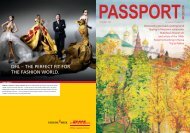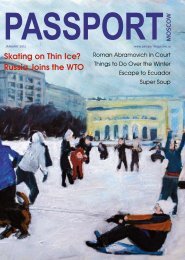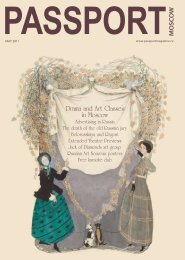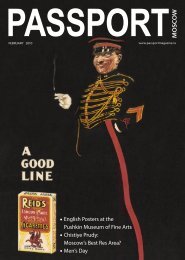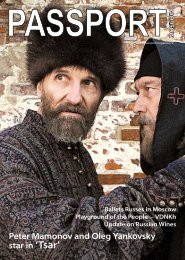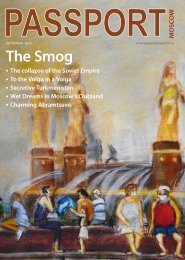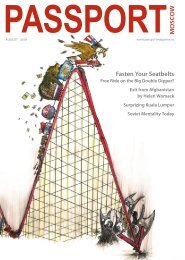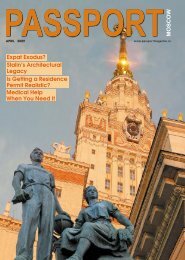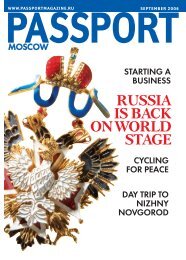M O S C O W Interview with Leonid Shishkin - Passport magazine
M O S C O W Interview with Leonid Shishkin - Passport magazine
M O S C O W Interview with Leonid Shishkin - Passport magazine
You also want an ePaper? Increase the reach of your titles
YUMPU automatically turns print PDFs into web optimized ePapers that Google loves.
Art<br />
Soviet Art wasn’t just<br />
Socialist Realism<br />
Why did you move to this hotel?<br />
I would never move to any other hotel. This is the only hotel<br />
I could move to because it is quintessentially Soviet, one of<br />
Stalin’s ‘wedding cakes’. Also, the new owners of the hotel have<br />
made a special point of presenting all 1,400 pieces of their collection<br />
of Soviet paintings and sculptures, which were mostly<br />
created in the 1950s, when the hotel was constructed, thus<br />
raising the etiquette and awareness of this period of culture<br />
in Moscow.<br />
Why do you specialise in Soviet Art?<br />
I used to be a journalist and worked for the <strong>magazine</strong>, Soviet<br />
Union. The <strong>magazine</strong> covered a lot of cultural themes, but<br />
it was all the official side, and I hated it. All my friends were<br />
underground painters, such as Nikolay Smirnov, and they<br />
suggested that I stage an exhibition highlighting the underground<br />
art of the time.<br />
I organised my first exhibition in 1987 in Prague, and I exhibited<br />
the work of all my non-conformist artist friends. It was successful.<br />
At about the same time I travelled around Russia, and returned<br />
to my home city Ekaterinburg. When I was living there I brought<br />
a few European landscapes, from one of the most famous artists<br />
of those days, just because I liked them. I came to understand<br />
that there was a huge difference between the artists of the older<br />
generation, who were taught by people who received their education<br />
before the revolution, and the new generation of artists.<br />
I began to understand that their work was of very good quality,<br />
and they were conscientious.<br />
As for my friends, I know most of them were inspired by Polish<br />
art <strong>magazine</strong>s, where they saw contemporary art that was<br />
not really so difficult to produce. I started to buy and collect Soviet<br />
Art. Just at that time, during Perestroika, an Italian antique<br />
dealer, Marco Datrino came to Russia <strong>with</strong> the idea of exporting<br />
Russian antiques. It was only when he got here did he find out<br />
that it was impossible to take antiques out of the country, and he<br />
wasn’t exactly bowled over by contemporary art. I showed him<br />
some Soviet art of the 1950s. He said: “Oh, I like this.” I sourced<br />
some paintings for his first big exhibition of this kind of art in<br />
12 June 2010<br />
<strong>Leonid</strong> <strong>Shishkin</strong> and his gallery are well known to many<br />
foreigners in Moscow who are interested in Soviet art. At the<br />
end of April, he opened a new gallery space in the atrium<br />
of the salubriously redecorated Ukraine Hotel. Paintings by<br />
Zinaida Serebryakova, Pyotr Konchalovsky, Yuri Pimenov and<br />
Alexandre Deineka’s adorn the walls. It is slightly shocking to<br />
see many works by these masters that I had previously seen<br />
only in art text-books hanging right in front of my eyes. But the<br />
everyman approach is misleading, some of these works have<br />
five or six figure (in dollars) price tags. John Harrison talked to<br />
<strong>Leonid</strong> about his life’s work.<br />
1990 in his gallery in Turin. We organised exhibitions in Turin together<br />
for three years. The first year was successful, the second<br />
was half as successful, and the third year, not successful.<br />
About this time, I made the acquaintance of Dmitry Nalbandyan.<br />
He was a very famous artist in Soviet times, but the intelligentsia<br />
and the artists didn’t like him because he was the only<br />
artist whom Stalin posed for. He also painted Khrushchev and<br />
Brezhnev, so he was a high-class court painter.<br />
During Perestroika, I saw an article in Ogonyok <strong>magazine</strong><br />
about him, which associated him <strong>with</strong> Soviet times and was<br />
pretty negative. I decided to go and see him, something that I<br />
could never have done before, as he was way too high for me.<br />
He son and wife had died, and he was a lonely old man. We had a<br />
long talk. He was a brilliant guy. Nobody liked him because they<br />
accused him of being a conformist during the Soviet Union. He<br />
actually was a foreigner, from Georgia. His attitude was that he<br />
simply wanted to be successful. He wasn’t too concerned about<br />
who was in power.<br />
I started to buy his paintings, which he sold very cheaply. That<br />
is how I got into dealing Soviet art.<br />
Please tell me more about Soviet Art<br />
It is a strange that the Soviet period is only known for one<br />
school of painting: Socialist Realism. In fact there were at least<br />
four different styles. Before the Soviet period, up to about 1920,<br />
the major schools in Russia were classicism as in the peredvizhniki<br />
school, and the Moscow impressionist school. Soviet art<br />
absorbed these and turned impressionism into Soviet impressionism,<br />
and the peredvizhniki into socialist realism. There was<br />
also the avant-garde movement as personified by Pyotr Konchalovsky,<br />
Aristarkh Lentulov, Alexandre Kuprin and the ‘Jack of<br />
Diamonds School’. This was a mixture of post-impressionism<br />
and Cezannism. Then there was constructivism, <strong>with</strong> artists like<br />
Yuri Pimenov and Alexandre Deineka, who were young in the<br />
twenties, and who were influenced by German expressionism<br />
and Art Deco.<br />
All of these four trends were mixed up, and collectively,<br />
it became known as Soviet Art. All the key players were full<br />
members of the Academy of Art, as were traditional artists like



